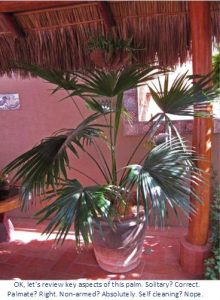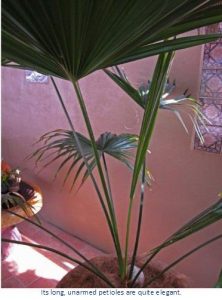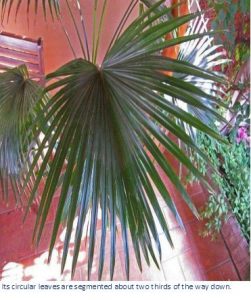By Tommy Clarkson from the April 2016 Edition
Florida Thatch Palm (Thrinax radiata)
Family: Arecaceae
Also known as: Silk-top Thatch Palm, Sea Thatch Palm, Jamaican Thatch Palm and Thatch Palm
Somewhat obviously, the origin of these is in the Florida Keys and the Northwestern Caribbean area. Today they can be found in the Bahamas, western Cuba, Cayman Islands, Jamaica, Hispaniola, Puerto Rico, the Yucatan Peninsula, Honduras and Nicaragua.
With its “weepy” fan leaves and narrow gray trunk, they are more commonly seen, by folks like us, along coastal highways in South Florida. (By way of further growth zone description, Naples is about as far north as they cares to grow. Like Patty and me, they are quite cold sensitive!) Beyond these areas more or less in the proverbial “wild” -they make wonderful landscape or container specimens.
A very slow grower, the Thrinax radiata will ultimately reach a height of around fifteen to twenty feet (meters) 15 to as high as 30 feet (4 ½ – 9 meters), with weepy fan leaves and a narrow gray trunk. Atop this will be 12-20 palmate, circular, slightly folded, fronds that are four to five feet wide.
 These palms are slow growers. Accordingly, mine is effectively used as a container plant. A small sized juvenile, it thrives in a large pot, with bright, indirect sunlight, under our Dining Palapa. In fact, I have not been to their native area for some time and, as a result, have not seen any larger ones “live and up close” enough to get any pictures. So, hopefully, the accompanying shots and my description will suffice in helping you identify one should opportunity present.
These palms are slow growers. Accordingly, mine is effectively used as a container plant. A small sized juvenile, it thrives in a large pot, with bright, indirect sunlight, under our Dining Palapa. In fact, I have not been to their native area for some time and, as a result, have not seen any larger ones “live and up close” enough to get any pictures. So, hopefully, the accompanying shots and my description will suffice in helping you identify one should opportunity present.
As a rule one sees them in solitary form, however, they can be grown in a multiple trunk form. Either way, they grow slowly and commences their growth appearing as a “palmetto type of plant” that is rather low to the ground. In this form, they make a great privacy screening growth.
Equally comfortable in sun or shade, it will only but grow slower when it receives less direct sunlight. Eventually, however, it commences to form that thin trunk. Some have observed that, as such, it lends itself to fitting in tight spaces.
Two other nice aspects to the Florida Thatch Palm are that its fruit are a good food source for birds and, in that once established it is quite drought and salt tolerant, as a result being a good selection for beachside locations.
When planting the, remember that they are hardy sorts – their natural environment is sandy soil . . . thus they don’t like wet areas or where the soil is thick and claylike. But, generally speaking, they demand no soil additions when planting. (Though we always sprinkle a bit of Raizal 400 on the root ball (for root growth stimulation) and add a bit of tierra negra (rich top soil) as well as some estiércol de vaca (dried cow manure) for natural nutrients. And, in our area, we actually have to add some arena de río (river sand to ensure good drainage. (Because of its natural salinity, do not use sand from the beach for your plants.)
don’t like wet areas or where the soil is thick and claylike. But, generally speaking, they demand no soil additions when planting. (Though we always sprinkle a bit of Raizal 400 on the root ball (for root growth stimulation) and add a bit of tierra negra (rich top soil) as well as some estiércol de vaca (dried cow manure) for natural nutrients. And, in our area, we actually have to add some arena de río (river sand to ensure good drainage. (Because of its natural salinity, do not use sand from the beach for your plants.)
The Florida Thatch Palms are not self-cleaners, accordingly, they will appreciate your gracious help in trimming off the dead fronds. (In this regard, however, remember my Number One Palm Rule NEVER cut off a palm frond until it is completely dead and brown!)
But up in those vibrant, live fronds, grow white flowers on yellow stems of three to four foot (.9 – 1.2 meters) in length, followed by round, green 1-1½” (2.5 – 3.8 cm) fruit that turns white when it is ripe.
Your Thrinax radiate likes fertilization three times yearly – in the 12/4/12 NPK range, with some micronutrients.
Singles of this species can be planted five to ten feet (1 ½ to three meters) apart or, should you wish to employ multi-trunk specimens, they can be placed close together to form a screening effect . . . when the palms are young.
So, just how all might one effectively use this guy in landscaping around one’s home? Beyond the earlier discussed privacy screen, they might be situated so as to be the principal feature in a small garden bed. They could be used in a smallish courtyard, entryway or for lining your driveway. Perhaps placement near a swimming pool or containerized as a patio plant would best suit your needs. Or, in a larger area, what about using them as a superlative accent under the canopy of a large palm?
For back issues of “Roots”, gardening tips, tropical plant book reviews and videos of numerous, highly unique eco/ adventure/ nature tours, as well as memorable “Ultimate Experiences” such as Tropical Garden Brunches
visit us at… www.olabrisagardens.com
Download the full edition or view it online
—
Tommy Clarkson is a bit of a renaissance man. He’s lived and worked in locales as disparate as the 1.2 square mile island of Kwajalein to war-torn Iraq, from aboard he and Patty’s boat berthed out of Sea Bright, NJ to Thailand, Germany, Hawaii and Viet Nam; He’s taught classes and courses on creative writing and mass communications from the elementary grades to graduate level; He’s spoken to a wide array of meetings, conferences and assemblages on topics as varied as Buddhism, strategic marketing and tropical plants; In the latter category he and Patty’s recently book, “The Civilized Jungle” – written for the lay gardener – has been heralded as “the best tropical plant book in the last ten years”; And, according to Trip Advisor, their spectacular tropical creation – Ola Brisa Gardens – is the “Number One Tour destination in Manzanillo”.




You must be logged in to post a comment.